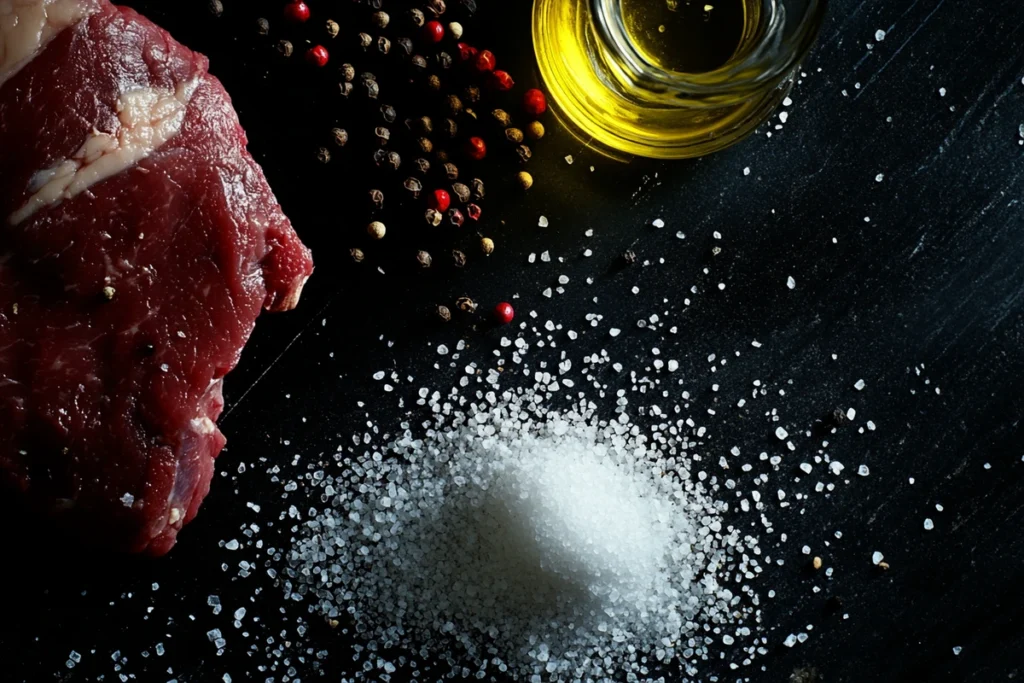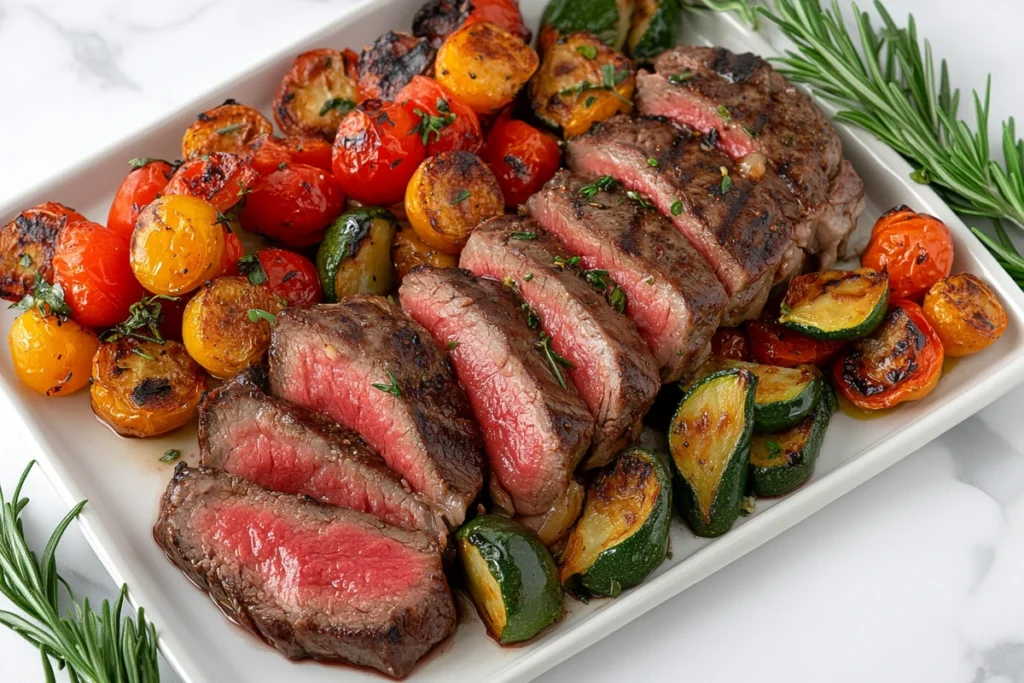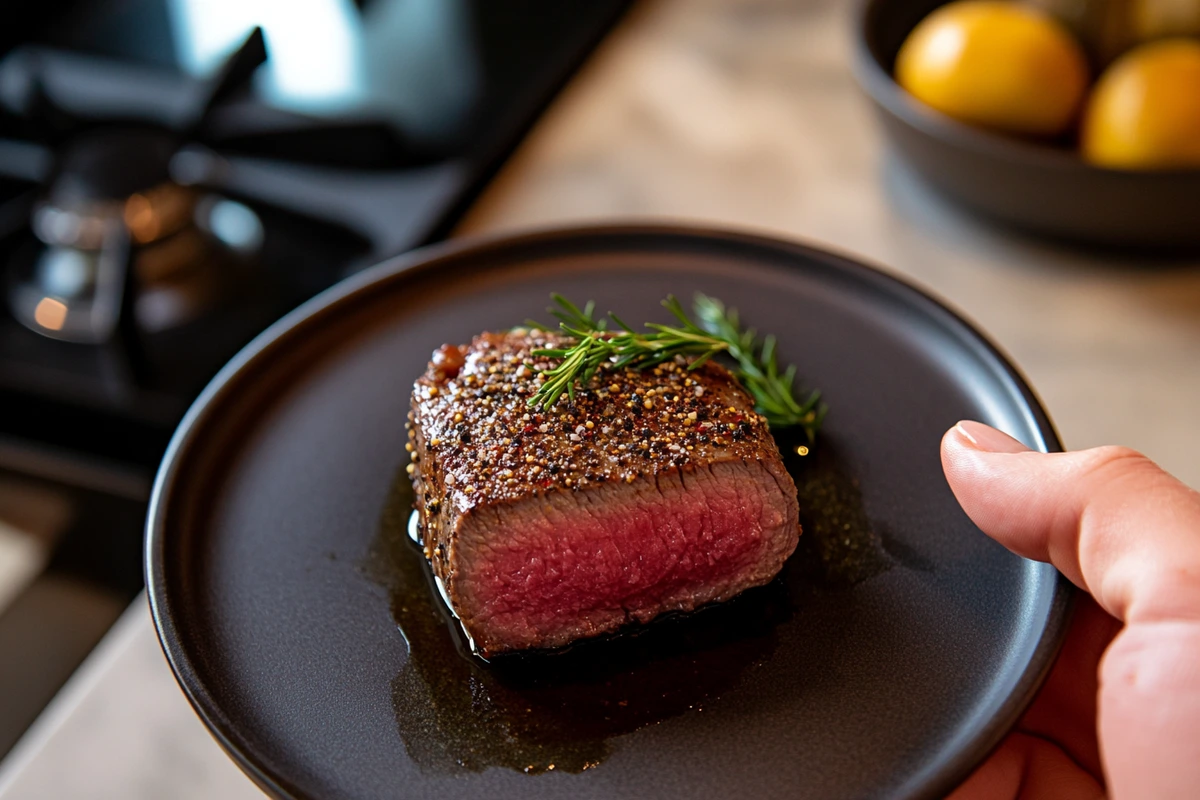Indulge in our complete guide to making a peppercorn crusted steak. Enjoy tips, techniques, and variations for a flavorful, show-stopping meal.
Introduction
Every bite of a peppercorn crusted steak offers bold zest and succulent texture. Packed with the aromatic crunch of cracked peppercorns, this dish transforms an ordinary cut of beef into a refined dining experience. In this article, we’ll explore the origins of peppercorn crust, optimal seasoning tactics, cooking methods, side pairings, and more.
I. Understanding the Peppercorn Crusted Steak
A peppercorn crusted steak centers on a flavorful crust of crushed peppercorns pressed onto the steak’s surface. Because peppercorns bring a slightly spicy bite, they contrast the meat’s natural richness. This approach offers variety beyond plain salt and pepper. Many steak enthusiasts relish the crunchy exterior matched with a juicy interior. Meanwhile, the crust provides fragrance and a distinctive texture, especially if combined with coarse salt or other seasonings.
Historically, pepper has been treasured across civilizations, traded as a precious spice. Culinary traditions eventually saw pepper used to coat meats, delivering bold flavor. Over time, restaurants popularized the peppercorn crusted steak for patrons craving intense taste. Eventually, home cooks tried it, discovering how straightforward it is: crush peppercorns, press them onto the steak, sear quickly, and watch as the steak’s surface browns into a crisp shell.
Apart from taste, a peppercorn crusted steak appeals visually. Speckled peppercorn pieces pepper the steak’s exterior, exuding an air of sophistication. Indeed, the dish suits both casual dinners and formal feasts.
II. Why Choose a Peppercorn Crusted Steak
Many home cooks admire a peppercorn crusted steak because it’s an effortless way to transform a simple steak into a gourmet treat. Another highlight is how peppercorns produce a deep, tangy, mildly pungent flavor that complements red meat perfectly. Additionally, the crunchy outer layer creates textural contrast with a tender center.
1. Flavor Impact: Traditional salt and pepper can be subtle. However, pressing cracked peppercorns into the surface yields a bolder dimension.
2. Ease of Preparation: The technique is straightforward: crush peppercorns, pat the steak, then cook. Even novice cooks can achieve success.
3. Versatility: This technique pairs well with sauces, from simple butter blends to full-bodied peppercorn sauce.
4. Eye-Catching Presentation: The speckled black crust looks impressive on a dinner plate, especially if served alongside bright vegetables or a crisp salad.
Moreover, you can pair your pepper-laden steak with a side of Zucchini Pasta if you want a healthier spin on typical carb-laden accompaniments. Another approach is to enjoy it with mashed potatoes or roasted veggies.
III. Selecting the Perfect Peppercorn Crusted Steak
Grading the beef cut and picking fresh peppercorns matter. Indeed, the final product’s taste depends on meat quality and pepper intensity. Below, we detail how to choose each element for optimum results.
A. Ideal Beef Cuts
- Ribeye: Known for marbling, yielding a juicy, rich flavor.
- Strip Steak: Sometimes called New York strip, with moderate marbling and a firm bite.
- Filet Mignon: Lean but tender, letting the pepper crust stand out.
- Sirloin: Economical cut with good flavor. Indeed, sirloin suits those seeking cost-effective options.
Pick whichever cut best suits your taste. Because a peppercorn crusted steak emphasizes crust, marbling can enhance moistness. Meanwhile, if you prefer lean cuts, a lightly marbled sirloin or filet mignon still works well.
B. Choosing Peppercorn Varieties of Peppercorn Crusted Steak
- Black Peppercorns: The classic choice for robust heat.
- Mixed Peppercorns: A medley of black, white, pink, or green peppercorns. This yields extra color and nuanced flavors.
- Freshly Cracked: Pre-ground pepper lacks the pungency of fresh cracks. In essence, crushing them yourself with a mortar and pestle or a rolling pin ensures maximum aroma.
C. Additional Seasonings of Peppercorn Crusted Steak
A simple salt-pepper approach works wonders. However, some cooks like adding garlic powder or dried herbs. Another route is mixing a small dash of onion powder or smoked paprika for extra complexity. Regardless, keep the focus on pepper. Eventually, if you want a marinade, ensure it doesn’t overshadow the pepper’s aroma. Because the crust must remain the highlight, too many competing spices can muddy the flavor.
IV. Preparing the Peppercorn Crusted Steak
Reading through a concise step-by-step plan helps you approach the cooking process confidently. This stage covers the key steps to ensure your steak emerges succulent and well-seasoned.

A. Drying and Seasoning
- Pat Steak Dry: Using paper towels, remove surface moisture. A dry surface browns better.
- Salt: Lightly salt each side. Let the salt rest on the steak for 20 minutes, if possible.
- Crush Peppercorns: In a mortar and pestle or with a rolling pin, crack them coarsely. Overly fine pepper might burn quickly.
- Press Peppercorns: Gently press the cracked peppercorns onto each side, forming an even coat.
B. Resting Before Cooking Peppercorn Crusted Steak
After the salt-press phase, let the steak rest at room temperature about 30–45 minutes. This not only allows the peppercorns to adhere but also helps the steak cook more evenly. Because going straight from fridge to pan can cause uneven internal temperatures, this rest step is crucial. Another tip: do not store your peppercorn-laden steak uncovered for too long, or the pepper might lose some potency.
C. Selecting a Cooking Method
You can sear your peppercorn crusted steak on a stovetop, grill it outdoors, or even broil it. Each approach has perks:
- Stovetop Skillet: Allows close control over searing. Use cast iron for an even crust.
- Grill: Achieves smoky char. Watch out for pepper bits that might fall off through grill grates.
- Oven Broiling: Good for finishing steak after a quick stovetop sear.
Consider your comfort level and available tools. For top results, many prefer cast iron searing. Meanwhile, you can always pop it in the oven to finish cooking if the steak is thick.
V. Cooking a Peppercorn Crusted Steak
This section dives into specific cooking times, temperatures, and tips for achieving a crust that’s crunchy yet not burnt. Additionally, we’ll cover how to gauge doneness without losing your pepper coating.
A. Stovetop Searing
- Heat the Pan: Medium-high is best. Add a drizzle of neutral oil with a high smoke point.
- Careful Placement: Lay the steak away from you. The peppercorns should sizzle but not scorch.
- Sear: About 2–4 minutes per side, forming a crust. If the steak is thick, reduce heat after the initial sear to cook it further.
- Optional Butter Basting: For extra richness, toss in butter, garlic, or herbs near the end. Spoon the sizzling butter over the crust.
B. Grilling with Confidence (H3 #8: Peppercorn Crusted Steak)
For a more open-flame approach:
- Preheat Grill: Aim for medium-high direct heat.
- Oil the Grates: Prevent peppercorns from sticking.
- Short and Hot: Cook 3–5 minutes per side, flipping once. Thick steaks might need a cooler zone for finishing.
- Watch the Crust: Because direct flames can burn pepper quickly, shift the steak if flare-ups occur.
C. Checking Doneness
Use either a meat thermometer or the finger test:
- Rare: About 120–125°F (49–52°C).
- Medium-Rare: Around 130–135°F (54–57°C).
- Medium: 140–145°F (60–63°C).
- Well-Done: 160°F (71°C) or higher.
Remember, the temperature can rise a few degrees while resting. Because overcooking can dull the steak’s juiciness, monitor carefully. Another detail: peppercorns can blacken faster than the interior cooks. Adjust your heat or cooking time to prevent scorching.
D. Resting Post-Cook
Always let your peppercorn crusted steak rest 5–10 minutes. This ensures juices redistribute, yielding a moist slice. During this rest, you can prepare a quick sauce if desired, or finalize side dishes like Avocado Toast with Feta for a funky pairing of flavors.
VI. Complementary Sauces for Peppercorn Crusted Steak
Though the peppery crust stands out on its own, many diners enjoy adding a sauce that harmonizes. Because peppercorn complements creamy or acidic sauces, your options abound.
A. Classic Cream Sauce
- Base: Typically includes heavy cream or half-and-half.
- Aromatics: Sauté shallots in butter, then add a splash of brandy or stock.
- Pepper Kick: If you want extra spice, add crushed peppercorns.
- Finishing: Let the sauce reduce to thick consistency, then drizzle over steak slices.
B. Wine Reduction
Red wine sauce can deepen the meaty flavors. Combine wine with beef or vegetable stock, reduce over heat, and swirl in butter. For bright tang, incorporate a small dose of balsamic vinegar. Because your crust already provides spice, keep this sauce subtle.
C. Mushroom Gravy
Sauté mushrooms in butter and garlic, then add stock and a small quantity of cream. The earthy mushrooms pair well with the bold pepper. Another advantage: mushrooms also soak up leftover bits from the steak pan, capturing every ounce of flavor.
D. Horseradish Cream
For an even sharper note, whisk prepared horseradish into sour cream or Greek yogurt. This sauce can cut the richness of the steak. Meanwhile, the pepper remains front and center, offering a spicy synergy. Add a pinch of salt or chives for a finishing touch.
VII. Sides and Pairings with Peppercorn Crusted Steak
Your peppercorn crusted steak can be the star, but it shines brighter with the right sidekicks. Classic combos include potatoes, roasted veggies, or fresh salads. Because the steak is intensely flavored, sides can either complement or contrast.
A. Traditional Sides
- Mashed Potatoes: The creamy texture counters the spiciness.
- Steamed or Grilled Veggies: Broccoli, asparagus, or Brussels sprouts lend crunch and color.
- French Fries: If you crave classic steak frites style, go for crisp fries.
- Bread Basket: Sop up juices with crusty bread or a soft dinner roll.
B. Light and Fresh Options (H3 #12: Peppercorn Crusted Steak)
- Salads: A crisp green salad with tangy vinaigrette keeps the meal from feeling too heavy.
- Zucchini Noodles: Alternatively, try Zucchini Pasta for a low-carb or lighter approach.
- Roasted Tomatoes: Slicing tomatoes in half, drizzling olive oil, and roasting intensifies sweetness, balancing pepper’s bite.
C. Hearty Soups or Appetizers
Beginning your meal with a small bowl of soup can be comforting. For instance, a spoonful of Vegetarian Tortilla Soup might offset the meaty main dish. Another approach is to provide an appetizer of deviled eggs or grilled vegetables, offering variety at the table.
VIII. Common Mistakes When Making Peppercorn Crusted Steak
While the method is straightforward, pitfalls can compromise your results. Recognizing them beforehand can save time and frustration.
- Forgetting to Dry the Steak: Excess moisture hinders browning and can cause steaming. Always pat the surface dry.
- Using Fine Pepper: Powdery pepper burns quickly and lacks interesting texture. Coarsely crushed is best.
- Skipping Rest Time: Without resting, your steak might become tough or lose juices upon slicing.
- High Heat Without Control: Pepper can scorch if the pan is too hot or if you sear it too long. Keep an eye on the crust’s color.
IX. Additional Variations of Peppercorn Crusted Steak
We’ve covered the classic approach. However, you can adapt your peppercorn crusted steak to different cuisines or preferences. Below are a few creative spins.
A. Herb-Infused Pepper Crust
Combine rosemary, thyme, or dried oregano with your crushed pepper. This herb-pepper blend adds an aromatic note. Because herbs can scorch, be mindful of cooking temperature. Lightly pat them onto the steak, ensuring they stick with a thin oil film.
B. Spice Medley
Replace half the pepper with chili flakes, coriander seeds, or smoked paprika for a bolder taste. The resulting spice rub intensifies color and flavor. Another possibility is a chipotle-laced pepper crust if you want southwestern flair.
C. Coffee and Pepper Mix
Some adventurous cooks incorporate finely ground coffee beans into the pepper rub. The coffee’s subtle bitterness underscores the steak’s savory profile. Indeed, the combination is more common than it sounds, especially in barbecue rubs. Because coffee can blacken, watch the heat carefully.
D. Crumb-Enhanced Crust
For an extra crunchy exterior, blend panko or breadcrumbs with the pepper. Press the mixture onto the steak. This technique yields a breaded effect, but the pepper remains the focal point. Because bread can soak oil quickly, you might want to use a quick, hot sear.
X. Serving and Presentation Tips for Peppercorn Crusted Steak
Once you’ve perfected your peppercorn crusted steak, consider how to plate it beautifully. Presentation helps elevate the meal’s overall feel, especially for special occasions.

A. Plating Essentials
- Warm Plates: Keep plates slightly heated so the steak stays hot.
- Simple Garnish: Fresh herbs or microgreens add color. Because the steak itself is visually striking, minimal garnish suffices.
- Sauce Placement: Drizzle sauce around or beneath the steak, not necessarily on top. This ensures you don’t obscure the pepper crust.
B. Slicing or Serving Whole
Some prefer to present the entire steak, letting diners cut their own slices. Others slice the steak partially on a diagonal, fanning it out to display the pink interior. If you slice, do so after resting. Keep pieces about half an inch thick to reveal the crisp pepper crust and succulent center.
C. Color Contrast
Pairing with bright vegetables—like carrots or green beans—makes the dish eye-catching. You could also place a fresh herb sprig or add a ring of sauce for a restaurant-style look. Another tactic is adding a small side dish of coleslaw or pickled onions to bring tanginess.
XI. Frequently Asked Questions about Peppercorn Crusted Steak
How to get pepper crust on steak?
Start by patting your steak dry. Then, press coarsely crushed peppercorns onto the surfaces. Lightly oil the steak or use the steak’s natural moisture to help the pepper stick. Finally, sear or grill to lock in the crust.
How do you get a black crust on a steak?
A black crust typically forms from intense heat and a rub that includes pepper or spices. For a peppercorn crusted steak, ensure your pan or grill is hot. However, avoid scorching. Briefly sear each side to develop a dark, flavorful exterior without burning.
How do you make Gordon Ramsay peppercorn sauce?
While Gordon Ramsay’s exact recipe varies, a typical peppercorn sauce involves sautéing shallots in butter, deglazing with brandy or wine, adding stock, cream, and crushed peppercorns. Simmer until it thickens. Serve alongside your peppercorn crusted steak for a restaurant-quality finish.
How do you get pepper to stick to steak?
Pat the steak dry first. Slightly moisten the surface with oil or allow the steak’s natural juices to help the cracked pepper adhere. Press the pepper in gently, ensuring good contact. This approach helps keep the pepper in place during searing or grilling.
Conclusion
A peppercorn crusted steak merges subtle spiciness and luscious beef into a single, compelling dish. When you handle your peppercorns carefully—coarsely crushing them, pressing them into the steak, and searing at the right temperature—you achieve a crisp, deeply flavored crust. Meanwhile, choosing a high-quality cut, letting the steak rest, and finishing with a sauce or side dish can make your meal remarkable. Whether you serve it with steamed vegetables, a hearty soup like Vegetarian Tortilla Soup, or a vibrant salad, the pepper-laden exterior ensures every bite bursts with character. Embrace this method, tweak it with your favorite spices, and enjoy a bold steak experience that’s both classic and surprising.

